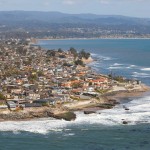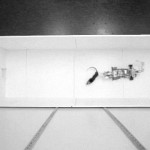We went on a class outing to the Santa Cruz Harbor last week. Our goal: Find crab fishermen and learn about their catch during the first two weeks of crab season. Biggie, a friendly sport fisherman in the bait shop, declared himself our teacher and gave us a lesson about the features of a crab pot.
Large steel bars weight the empty pot and keep it from “walking” along the ocean floor. But steel (mostly iron) rusts in saltwater, eventually destroying the weight. To save the steel, fishermen attach a small metal puck (usually zinc) to the bar. The zinc puck is changed many times before the steel corrodes completely. In the photo above, the rusty steel bar with a silvery disk attached is left of center.
But if iron and zinc both react with saltwater, why don’t they both corrode at their normal rates? How does the zinc protect the iron from rusting?
Seawater conducts electricity. Once the crab pot is in the water, the zinc disk spontaneously transfers electrons to the iron bar through the screw that connects them. Extra electrons flowing from the iron into the water interfere with the rust-forming chemical reactions. The steel bar does rust, but the reactions don’t happen as often.
Substitute seawater for soil, and this video does a decent job of providing a visual. At 0:30, the text says aluminum while the image shows zinc. The picture is correct.








Thank you for the elegant explanation, Melissae. My favorite part of this outing was the pile of crabs that was two feet deep. Amazing! And then the first mate of the troller told us that earlier in the day it had been seven feet deep. An approximately 5’x3′ box of living Dungeness crabs, SEVEN FEET DEEP! It blew my mind.
Thanks, Melissae! I should have gotten to know a chemist YEARS ago. So many things could have been so much clearer.
Glad it helped. I was amazed that the first mate said he could walk on the seven-foot pile of crabs and the ones at the bottom wouldn’t get crushed.
Thanks for the explanation Melissae! It makes sense now :)